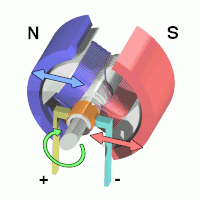
Photo from wikipedia
Dielectric ceramic film capacitors, which store energy in the form of electric polarization, are promising for miniature pulsed power electronic device applications. For a superior energy storage performance of the… Click to show full abstract
Dielectric ceramic film capacitors, which store energy in the form of electric polarization, are promising for miniature pulsed power electronic device applications. For a superior energy storage performance of the capacitors, large recoverable energy density, along with high efficiency, high power density, fast charge/discharge rate, and good thermal/fatigue stability, is desired. Herein, we present highly dense lead-free 0.942[Na0.535K0.480NbO3]-0.058LiNbO3 (KNNLN) ferroelectric ceramic thick films (∼5 μm) demonstrating remarkable energy storage performance. The nanocrystalline KNNLN thick film fabricated by aerosol deposition (AD) process and annealed at 600 °C displayed a quasi-relaxor ferroelectric behavior, which is in contrast to the typical ferroelectric nature of the KNNLN ceramic in its bulk form. The AD film exhibited a large recoverable energy density of 23.4 J/cm3, with an efficiency of over 70% under the electric field of 1400 kV/cm. Besides, an ultrahigh power density of 38.8 MW/cm3 together with a fast discharge speed of 0.45 μs, good fatigue endurance (up to 106 cycles), and thermal stability in a wide temperature range of 20-160 °C was also observed. Using the AD process, we could make a highly dense microstructure of the film containing nano-sized grains, which gave rise to the quasi-relaxor ferroelectric characteristics and the remarkable energy storage properties.
Journal Title: ACS applied materials & interfaces
Year Published: 2018
Link to full text (if available)
Share on Social Media: Sign Up to like & get
recommendations!